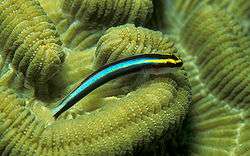Elacatinus evelynae
| Elacatinus evelynae | |
|---|---|
 | |
| Elacatinus evelynae resting on a boulder brain coral (Colpophyllia natans) | |
| Not evaluated (IUCN 3.1) | |
| Scientific classification | |
| Kingdom: | Animalia |
| Phylum: | Chordata |
| Class: | Actinopterygii |
| Order: | Perciformes |
| Family: | Gobiidae |
| Subfamily: | Gobiinae |
| Genus: | Elacatinus |
| Species: | Elacatinus evelynae |
| Binomial name | |
| Elacatinus evelynae (J. E. Böhlke & C. R. Robins, 1968) | |
| Synonyms | |
| |
Elacatinus evelynae, the Sharknose goby, is a species of goby native to the Western Atlantic Ocean from the Bahamas and the Lesser Antilles to the northern coast of South America, as well as the Antilles and western Caribbean.[1]
Appearance
Elacatinus evelynae are very small, torpedo-shaped fish. They can reach a maximum length of 4 cm (1.6 in). They have a yellow stripe in front of each eye that joins to form a V near the tip of their snout. Black strips run under the yellow ones from the snout, over the lower part of the eye to the end of the caudal fin.[1] E. evelynae's fin configuration is the same as all other gobies. Their dorsal fin is split in two, with a rounded anterior fin and a flat posterior fin which lines up with their anal fin. The pectoral fins are almost circular. All their fins are transparent.
Habitat
They inhabit coral reefs in clear ocean waters at a depth of 1–53 m (3 ft 3 in–173 ft 11 in). The reported temperature range where they are found is 22 °C (72 °F) to 27 °C (81 °F).[1]
Diet
E. evelynae is a cleaner fish as indicated by one of its common names, the Caribbean cleaning goby. They feed on ectoparasites found on other fish.[1] Females tend to clean and feed more than males especially if they are accompanied by a large male, which may be due to mate guarding and the male spending more time guarding the eggs.[2]
Reproduction
They are monogamous and are usually found in pairs near coral heads. Both males and females will show aggression towards potential intruders of the same sex in order to protect their mate.[3] Attempts to breed them in captivity have shown that they will not produce eggs unless there is optimal condition, with little to no fluctuation in temperature and salinity.[4]
References
- 1 2 3 4 "Elacatinus evelynae (Böhlke & Robins, 1968)". Fish Base. Retrieved August 8, 2012.
- ↑ Rohde, Klaus (2005). Marine Parasitology. Csiro Publishing. ISBN 9780643099272.
- ↑ Whiteman, Elizabeth A.; Côté, Isabelle M. (August 2003). "Social monogamy in the cleaning goby Elacatinus evelynae: ecological constraints or net benefit?". Animal Behaviour. 66: 281–291. doi:10.1006/anbe.2003.2200.
- ↑ Baker, Erin; Becker, Eliza; Foster, Bridgette; Martin-Katz, Ben; Quayle, Peter; Triedman, Lucy. "Breeding of the Sharknose Goby (Gobiosoma evelynae) in captivity with a comparison of substrates for spawning" (PDF). Fisheries Conservation Foundation. Retrieved August 8, 2012.